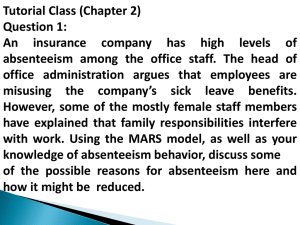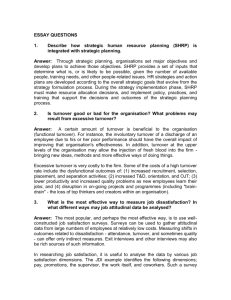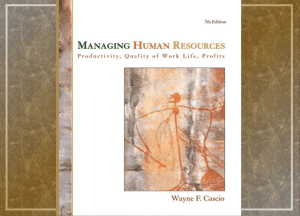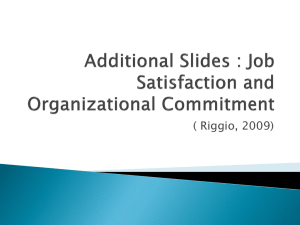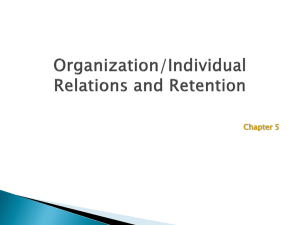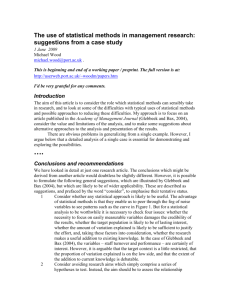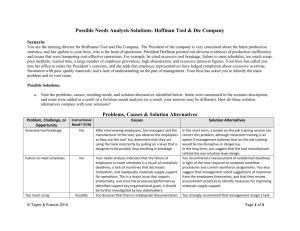How Much Is Conflict Costing You?
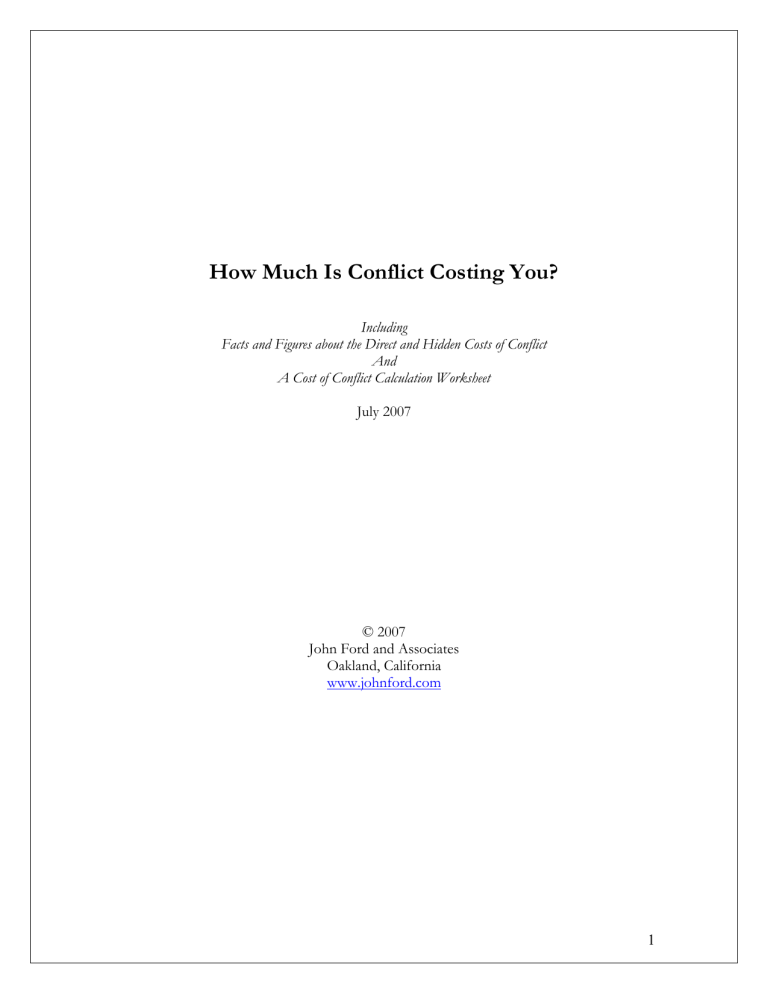
How Much Is Conflict Costing You?
Including
Facts and Figures about the Direct and Hidden Costs of Conflict
And
A Cost of Conflict Calculation Worksheet
July 2007
© 2007
John Ford and Associates
Oakland, California www.johnford.com
1
Measuring Conflict - What is it?
If we are going to measure the cost of conflict to an organization, we must know what to look for. What should we consider as conflict? Conflict is a difference about how expected needs are going to be met and we typically know we are in a conflict because of the emotional tension we experience. At a behavioral level we become aware of either distancing or combative strategies: gossip, avoidance, verbal abuse, passive/aggressive communication, and hostility. Conflict can be demonstrated by not returning phone calls, not having coffee with your colleague any more and filing complaints, grievances or lawsuits. At its combative extreme, conflict involves physical violence.
Direct Costs
Legal fees paid for conflict that escalates into a legal dispute are the most visible costs. Another cost that is easy to measure is insurance. Both legal fees and insurance costs can be determined from the company's financial statements. In
1986 the Rand Corporation estimated that it cost $100 000 to defend a wrongful termination suit. Today, employer defense fees are much higher. Theft and sabotage are both direct costs that can also be computed. The challenge is in showing the relationship of these costs to a particular conflict or employee.
The "Hidden" Costs of Conflict
Computing direct "conflict-related" costs can provide useful data; however, there are significant hidden costs within employee conflicts, costs that an organization incurs long before a lawsuit is filed.
For example, a team member's commitment to the team and the team mission can decrease if intra-team conflict remains unresolved. Conversely, if intra-team conflict is actively managed and resolved, the team member's chances for success within the team increases. Research shows that if unhealthy conflict goes unresolved for too long, team members are likely to leave the company or use valuable time to search for alternatives.
The Evidence of the Hidden Costs of Conflict
Several commonly tracked employee metrics can provide a wealth of data to analyze and track the true costs of conflict. Time spent, absenteeism, turnover and grievance filing are the prime indicators of workplace conflict. Measuring the costs of each of these factors can be used to demonstrate the added value of human resources interventions such as training and performance management.
2
Quantifying Time Spent Dealing with Conflict
The cost of resolving a conflict can involve the salaries of as many as four employees: the two who are in conflict, their manager, and the HR manager. It is estimated that Fortune 500 senior HR executives spend up to 20% of their time in litigation activities. Studies show that up to 30% of a typical manager's time is spent dealing with conflict.
Absenteeism
Absenteeism is a conflict-related hidden cost that can be measured using a simple formula provided by the U.S. Department of Labor. Experts suggest that your absenteeism goal should be 3% or lower rather than the current average of 6% percent per annum.
The Journal of Occupational and Environmental Medicine reports that health care expenditures are nearly 50% greater for workers who report high levels of stress and many studies suggest that stress is a byproduct of a conflicted work environment. Stress has seen a 316% increase as a reason for absenteeism since
1995. (1999 Unscheduled Absence Survey by CCH Inc)
Turnover
Turnover is another hidden cost of unresolved conflict. The business costs and impact of employee turnover can be grouped into five major categories:
1. Severance costs - voluntary or involuntary
2. Benefits costs - compensation, etc.
3. Recruitment & staffing cycle time costs,
4. Training & Development costs,
5. Lost productivity costs.
Figures vary, but the turnover cost of one employee can be anywhere from 30% to 150% of the employees annual salary.
3
Grievance Filing
For companies with union represented employees, it is possible to benchmark the number of grievances filed per month. The cost per grievance can be distilled to determine the estimated costs to resolve a grievance at the first, secondary and termination levels. It is also useful to compare grievances filed per month with the number filed after training or other performance improvement intervention
Conclusion
It is well known that every dollar of avoided cost drops straight through to the bottom line, while only a percentage of every dollar of increased sales gets there.
In this day and age of tight margins, reducing operating costs through better management of conflict is a path more and more of the best companies are taking.
It is ironic that many executives still hesitate to invest time and money in improving their employees' conflict management resiliency when the net added value to the company's bottom line can be documented. To derive a rough estimate of what conflict is costing your organization and what you could save annually by managing it better; please complete the worksheet at the end of this paper.
4
Direct and Hidden Costs: Facts and Figures
PART A: DIRECT COSTS
Increasing Complaints and Litigation
The general federal civil caseload increased by 125% between 1970 and 1989. In contrast employment discrimination case filings recorded a 2,166% increase.
Federal Courts Study Committee, (1989) "Tentative Recommendations for Public Comment." Proposed
Long Range Plans for Federal Courts.
This trend has continued: in 1991 there were 35% more cases than in 1990, and by 1996 more than double the number filed in 1990.
The Eisenberg-Clermont Database
The EEOC reported a 22% increase in charges of employment discrimination from 1991 to
1993.
Bureau of National Affairs, Daily Labor Report, July 29,1994 at D20.
Retaliation complaints more than doubled between 1991 and 1998, with 31,059 cases filed in
1998.
EEOC statistics at www.eeoc.gov/stats
Increasing Litigation Costs
According to the Rand Corporation, the average amount spent by companies in defending wrongful termination lawsuits from 1980 to 1986 was about $100,000 per case. The updated figure for 2010 is $150, 000 per case.
Risser, R (1993) "Stay out of Court: The Manager's Guide to Preventing Employee's Lawsuits," Prentice
Hall.
"Even when the employer prevails on summary judgment, he has usually spent $50,000 or more in attorney's fees, in addition to the organizations time and resources."
McDermott, E with Berkeley, A (1996) "Alternative Dispute Resolution in the Workplace: Concepts and
Techniques for Human Resource Executives and their Counsel." Quorum Books, at pxviii
Years ago, if a situation had more than $100,000 at stake, litigation was a viable alternative.
Today, the benchmark is $1 million and growing quickly.
Stewart Levine (1998) www.resolutionworks.org
5
Increasing Financial Risk
From 1992 to 1993 awards from judges and juries in sexual harassment cases increased 98% to a record $25,2 million.
Stickler, K (1994) "For Job-Bias Suits, Ballooning Costs." New York Times, Sunday, July 17, 1994, at p F11.
According to a nationwide study, the average jury verdict in wrongful termination cases is over $600,000 and companies lose 64% of the cases.
"Without Just Cause: An Employer's Practical Guide on Wrongful Discharge," (1988) Bureau of
National Affairs.
Annual monetary benefits for sexual harassment cases handled by the EEOC between 1992 and 1998 have increased from $12,7 million to $34.5 million. The figure for FY 1999 is $50.3 million and for FY 2000 is $54.6 million. These figures do not include monetary benefits obtained through litigation.
EEOC statistics at www.eeoc.gov/stats
Annual monetary benefits for ADA cases handled by the EEOC between July 26, 1992 and
1998 have increased from $0.2million to $49,1 million. The figure for FY 1999 is $49.9 million and for FY 2000 is $47.9 million.
These figures do not include monetary benefits obtained through litigation.
EEOC statistics at www.eeoc.gov/stats
A survey by the ABA of employment discrimination cases brought under Title I of the
Americans with Disabilities Act reveals that employers prevail 96.4 percent of the time in court, and 76.4 percent of the time in administrative complaints handled by the Equal
Employment Opportunity Commission.
July-August 2001 issue of the American Bar Association's Mental & Physical Disability Law Reporter.
Sabotage
Employee sabotage occurs when an employee intentionally inflicts damage on the organization or one of its members, ultimately inflicting a loss in production or profit.
There is a direct correlation between prevalence of employee conflict and the amount of damage and theft of inventory and equipment.
Dana, D (1997) Managing Differences
A survey of 1305 adults in the workplace revealed that 14% had observed Damage of machines or furniture
Source: Business Week
Integra Realty Resources' Oct-Nov 2000
6
PART B: HIDDEN COSTS
Time
"It takes an average of two years for the EEOC to investigate most claims."
Busch, R II "The Conundrum: Conflict- The Solution: Designing Effective Conflict Management Systems,"
16 Preventative L. Rep. Note 4 at 13 (1997)
"The median time between the date a lawsuit is filed and the commencement of a civil trail is
2.5 years."
Busch, R II "The Conundrum: Conflict- The Solution: Designing Effective Conflict Management Systems,"
16 Preventative L. Rep. Note 4 at 13 (1997)
Fortune 500 Senior executives spend 20% of their time in litigation activities.
Stewart Levine (1998) www.resolutionworks.org/cost_calculator.htm
Up to 30% of a typical managers time is spent dealing with conflict.
Thomas, K and Schmidt, W. (1976) "A survey of managerial interests with respect to conflict. Academy of
Management Journal," June 1976.
A more current study showed that 42% of a manager's time is spent on reaching agreement with others when conflicts occur.
Watson, C and Hoffman, R (1996) " Managers as Negotiators," Leadership Quarterly 7 (1) 1996
Absenteeism
Stress has seen a 316% increase as a reason for absenteeism since 1995.
1999 Unscheduled Absence Survey by CCH Inc
The cost of unscheduled absenteeism is as high as $602 per employee annually.
1999 Unscheduled Absence Survey by CCH Inc
Absenteeism Rate = (Number of lost working days due to absence) x 100
(Number of employees) x (Number of Workdays)
U.S. Department of Labor Formula
Your absenteeism goal should be 3 percent instead of 6 percent per annum.
Levine, G. (1999) “Absenteeism-Causes and Cures”
Absenteeism accounts for a 10% loss of productivity for employees in conflict.
Dan Dana, Mediation Training Institute International
7
Turnover
The turnover costs for an employee is anywhere between 75% and 150% of the annual salary.
Phillips, D.T. (1990) "The Price Tag of Turnover." Personnel Journal, Dec. 1990, at p 58.
Another more conservative estimate suggests that the cost of replacing an employee ranges from 29% to 46% of the persons annual salary.
Bernthal, P and Wellins, R
HR Benchmark Group, Issue 2 (vol 3) February 2001
The Bureau of Labor Statistics use 30% as the base cost of replacing a worker and calculates the rate of turnover by dividing the number of employee separations during the month with the total number of employees at mid month.
What is a healthy turnover rate?
34.09% for the bottom 10% of corporations
20.87% for the top 10% of corporations
Excerpt from The HR Scorecard: Linking People, Strategy, and Performance , by Brian Becker, Mark
Huselid, and David Ulrich. Harvard Business School Press.
The business costs and impact of employee turnover can be grouped into four major categories: 1) Costs due to a person leaving; 2) hiring costs; 3) training costs; and 4) lost productivity costs.
The Business Cost and Impact of Employee Turnover http://www.blissassociates.com/html/articles/employee_turnover01.html
8
Cost of Conflict Worksheet
A: Direct Costs
1. Legal and other Professional Fees
Name of Professional
2. Sabotage
Equipment Replaced or Repaired
B: Hidden Costs
3. Lost Time
Employee Name/Position Hourly Rate of
Pay
Hours spent on conflict
Grand Totals
4. Absenteeism
4.1
Calculate the absenteeism rate for the employees in question
Employee Name/Position Number of days absent
Number of work days since during the conflict becoming involved in conflict
Grand Totals
Total Bill
Total Bill
Total Cost
Annual Salary
9
Absenteeism Rate = (Number of lost working days due to absence) x 100
(Number of employees) x (Number of Workdays)
4.2 Calculate the loss of productivity for the employees in question.
For an absenteeism rate of 3% assume a 10% loss of productivity
For an absenteeism rate of 4% assume a 12% loss of productivity
For an absenteeism rate of 5% assume a 14% loss of productivity
For an absenteeism rate of 6% assume a 16% loss of productivity
Loss of Productivity = Total Annual Salary X Total Duration of Conflict (Weeks)
Total Work Year (Weeks) X 10%, 12%, etc
Loss of Productivity = _____________ X __________________ (Weeks)
____________ (Weeks) X ___%
Total Loss of Productivity Due to Absenteeism = $
5. Turnover
Name/Position of Employees who were involved in the
Degree to which decision to resign was as a result of the
Annual Salary conflict and resigned
Grand Totals conflict (expressed as a %)
Turnover Costs = Annual Salary X Decision Reason as a % X 150%
Turnover Costs = $_________ X _______________% X 150%
$ Total Loss Due to Turnover =
SUMMARY
1. Legal and other Professional Fees
2. Sabotage
3. Lost Time
4. Absenteeism: Loss of Productivity
5. Turnover
Grand Total
$
$
$
$
$
$
10
